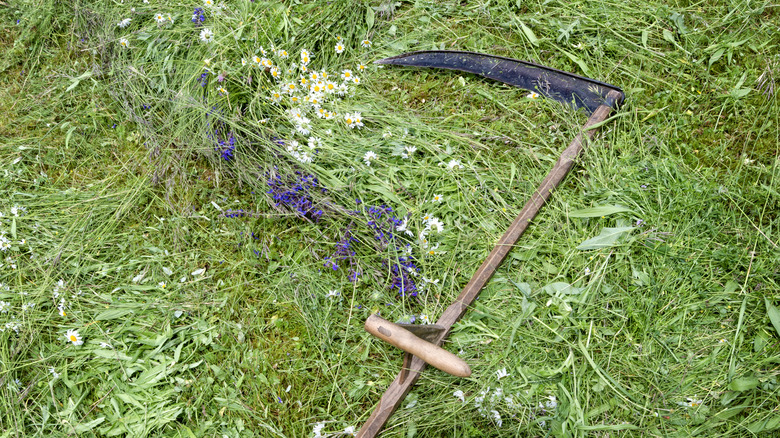Cutting The Lawn With A Scythe Is An Eco-Friendly Alternative To A Mower
While gas powered mowers are the norm for cutting lawns and fields across much of North America and Europe these days, they're far from the only way to keep grass at a manageable height. The scythe, an impressively efficient tool that has existed since before the Middle Ages and is still widely used in many parts of the world, has been seeing a resurgence among North American homeowners and small farmers who are sick of the noise, pollution, and cost that comes with gas mowers. While scythes may look intimidating, and do take time to learn how to use and maintain, many people find them a meditative and satisfying way to take care of lawns and fields without harming the environment.
Princeton University reports that gas powered lawn mowers account for 5% of the air pollution in the United States. Electric mowers, while greener, using lithium-ion batteries and power from the electric grid. Given these factors, it's unsurprising that many people are looking for more eco-friendly ways to care for their yards. While mowing with a reel mower provides a healthy lawn and no emissions, it's hard to beat the mystique and history of a scythe. Cooperative extensions are even beginning to offer in-person scythe classes for anyone looking to gain hands-on experience with this ancient and practical skill. Many online specialty shops offer scythes and accessories and because the tool is so durable, scythes are also often available second hand.
Setting up and using a scythe
A scythe consists of a blade and a handle with two grips. To use your scythe, make sure the blade is securely attached at the bottom of the handle and then check that the grips are properly adjusted for your height, with the lower grip roughly at hip height when the blade is on the ground. The upper grip should be the same distance from the lower grip that your elbow is from your index finger. Having your grips set up well ensures you won't have to stoop over while working, making the job more comfortable and ergonomic.
Once your scythe is set up and your blade is sharp, you're ready to start cutting your grass. Make sure there aren't any people, pets, or obstacles nearby and then stand with your dominant leg slightly behind your non-dominant leg and place your dominant hand on the lower grip and your nondominant hand on the upper grip. Then smoothly sweep the scythe through the grass in front of you. Ideally you should leave at least 2 inches of grass and avoid taking off more than ⅓ of the grass's height at a time, as that is the best height to mow your lawn to, though it can be difficult to achieve with a scythe. Try to avoid "scalping" your lawn, that is, cutting it so short it damages the grass, making the turf brown. If the blade isn't cutting well, try adjusting the angle.
Sharpening and caring for your scythe
Keeping your blade clean and sharp is an essential part of using a scythe. The blade should generally be cleaned, sharpened, and peened every time it is used, or it will quickly lose effectiveness. Before working on your scythe's blade, it's best to remove it from the handle to make it easier to manage and to allow it to fit in a vice. To clean the blade of the scythe simply use a hand sander to remove any vegetation or residue from the blade, and then sharpen it using a file or whetstone, just as you would sharpen other metal blades, like the ones on your weed wacker.
Scythe blades also need to be peened, that is, given a thinner edge, regularly. This can be a challenging skill to learn, and while it can be done with just a hammer and anvil, beginners may want to invest in a specialized peening jig which can assist with this. A peening jig consists of a base and two caps which make it easier to use a hammer to shape the edge of the blade. Remember to sharpen your blade after peening. If you're not quite ready to take care of peening and sharpening your scythe on your own, you may also be able to find a local professional who can help keep the blade in top condition.

